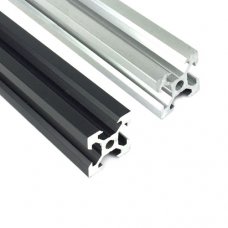Hey all,
My desk is already kind of cluttered cluttered, and I'm on the verge of ordering a Thunderbay 6 (6-bay drive case) and Mercury Helios FX (eGPU) from OWC, so I've been thinking about making a small(-ish) frame from 2020/2080 Aluminium profile pieces, to allow stacking the Drive bay, eGPU and then Mac mini (not necessarily in that order) vertically.
For those that aren't aware Aluminium profile like this is typically used to build small CNC machines/3d printers. The nice thing is, it comes in a variety of pre-cut lengths, and there's a bunch of various brackets/etc to work with the T/V-slots in the profile.


My plan so far is to build a fairly basic vertical frame from 2020 (i.e. 4 corner posts @ ~500mm), with horizontal rails forming a rectangle (~200mm x ~400mm) and then use panels of 200mm 2080 flat between the two long rails, spaced about ~55mm apart (to increase air flow, as a bonus this will decrease material costs). I'd planned to have 3 shelf layers - one almost at the bottom, effectively providing stiffness to the frame, and allowing more airflow below whatever is on the bottom shelf, one roughly middle, and one at the very top of the frame (so the posts are flush). This works on the theory of the eGPU/Drive case being in the bottom/middle (no specific order) and the Mini being on top, as it'll be easiest to reach, and likely get the best ventilation (the other two have bigger cases and bigger fans).
So, my question is - has anyone tried/failed/succeeded with this before, and if so, any tips/gotchas I should be aware of?
On a related note - can anyone suggest software that might help me diagram this in a meaningful way (i.e. to actually allow measurements and the 3d nature of the object) without needing thousands of dollars and hundreds of hours investment before I can actually use it? So far I've been sketching on paper to try and get an idea of what materials/sizes I need.
My desk is already kind of cluttered cluttered, and I'm on the verge of ordering a Thunderbay 6 (6-bay drive case) and Mercury Helios FX (eGPU) from OWC, so I've been thinking about making a small(-ish) frame from 2020/2080 Aluminium profile pieces, to allow stacking the Drive bay, eGPU and then Mac mini (not necessarily in that order) vertically.
For those that aren't aware Aluminium profile like this is typically used to build small CNC machines/3d printers. The nice thing is, it comes in a variety of pre-cut lengths, and there's a bunch of various brackets/etc to work with the T/V-slots in the profile.


My plan so far is to build a fairly basic vertical frame from 2020 (i.e. 4 corner posts @ ~500mm), with horizontal rails forming a rectangle (~200mm x ~400mm) and then use panels of 200mm 2080 flat between the two long rails, spaced about ~55mm apart (to increase air flow, as a bonus this will decrease material costs). I'd planned to have 3 shelf layers - one almost at the bottom, effectively providing stiffness to the frame, and allowing more airflow below whatever is on the bottom shelf, one roughly middle, and one at the very top of the frame (so the posts are flush). This works on the theory of the eGPU/Drive case being in the bottom/middle (no specific order) and the Mini being on top, as it'll be easiest to reach, and likely get the best ventilation (the other two have bigger cases and bigger fans).
So, my question is - has anyone tried/failed/succeeded with this before, and if so, any tips/gotchas I should be aware of?
On a related note - can anyone suggest software that might help me diagram this in a meaningful way (i.e. to actually allow measurements and the 3d nature of the object) without needing thousands of dollars and hundreds of hours investment before I can actually use it? So far I've been sketching on paper to try and get an idea of what materials/sizes I need.

